JVCKENWOOD 452701 UHF Digital Transceiver User Manual NX 740H NX 740HV NX 840H NX 840HU
JVC KENWOOD Corporation UHF Digital Transceiver NX 740H NX 740HV NX 840H NX 840HU
Contents
- 1. User Manual
- 2. User Manual RF Exposure
User Manual

VHF DIGITAL TRANSCEIVER
NX-740H NX-740HV
UHF DIGITAL TRANSCEIVER
NX-840H NX-840HU
INSTRUCTION MANUAL
© B5A-0031-10 (K)

i
One or more of the following statements may be applicable:
FCC WARNING
This equipment generates or uses radio frequency energy. Changes or modifi cations to this
equipment may cause harmful interference unless the modifi cations are expressly approved in the
instruction manual. The user could lose the authority to operate this equipment if an unauthorized
change or modifi cation is made.
INFORMATION TO THE DIGITAL DEVICE USER REQUIRED BY THE FCC
This equipment has been tested and found to comply with the limits for a Class B digital device,
pursuant to Part 15 of the FCC Rules. These limits are designed to provide reasonable protection
against harmful interference in a residential installation.
This equipment generates, uses and can generate radio frequency energy and, if not installed and
used in accordance with the instructions, may cause harmful interference to radio communications.
However, there is no guarantee that the interference will not occur in a particular installation. If this
equipment does cause harmful interference to radio or television reception, which can be determined
by turning the equipment off and on, the user is encouraged to try to correct the interference by one
or more of the following measures:
• Reorient or relocate the receiving antenna.
• Increase the separation between the equipment and receiver.
• Connect the equipment to an outlet on a circuit different from that to which the receiver is
connected.
• Consult the dealer for technical assistance.
THANK YOU
We are grateful you have chosen KENWOOD for your personal mobile applications.
This instruction manual covers only the basic operations of your mobile radio. Ask your dealer for
information on any customized features they may have added to your radio.
NOTICES TO THE USER
◆ Government law prohibits the operation of unlicensed transmitters within the territories under
government control.
◆ Illegal operation is punishable by fi ne and/or imprisonment.
◆ Refer service to qualifi ed technicians only.
SAFETY: It is important that the operator is aware of, and understands, hazards
common to the operation of any transceiver.
◆ EXPLOSIVE ATMOSPHERES (GASES, DUST, FUMES, etc.)
Turn OFF your transceiver while taking on fuel or while parked in gasoline service stations. Do
not carry spare fuel containers in the trunk of your vehicle if your transceiver is mounted in the
trunk area.
◆ INJURY FROM RADIO FREQUENCY TRANSMISSIONS
Do not operate your transceiver when somebody is either standing near to or touching the
antenna, to avoid the possibility of radio frequency burns or related physical injury.
◆ DYNAMITE BLASTING CAPS
Operating the transceiver within 500 feet (150 m) of dynamite blasting caps may cause them
to explode. Turn OFF your transceiver when in an area where blasting is in progress, or where
“TURN OFF TWO-WAY RADIO” signs have been posted. If you are transporting blasting caps
in your vehicle, make sure they are carried in a closed metal box with a padded interior. Do not
transmit while the caps are being placed into or removed from the container.
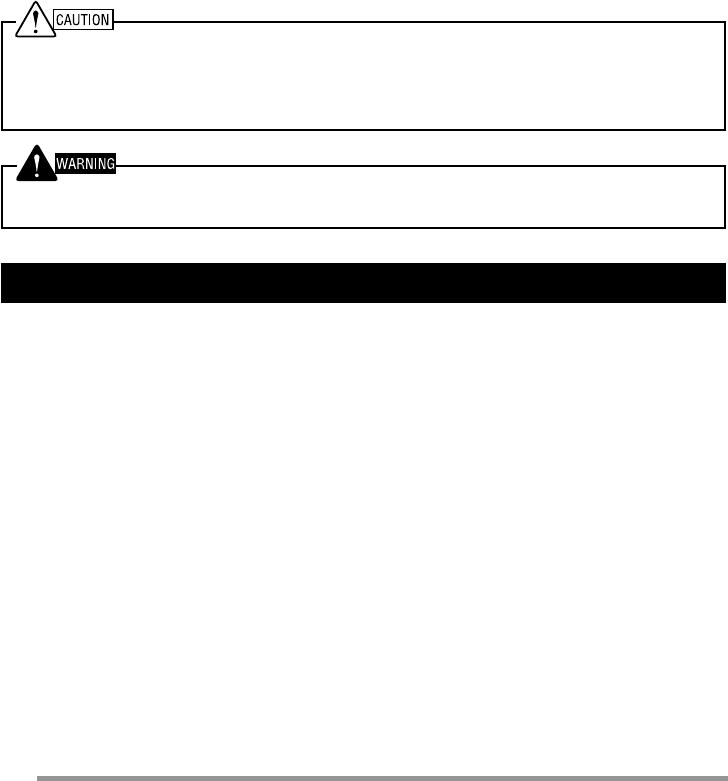
ii
CONTENTS
GETTING STARTED .................................................................................................1
GETTING ACQUAINTED ..........................................................................................3
PROGRAMMABLE FUNCTIONS .............................................................................6
BASIC OPERATIONS ...............................................................................................6
NXDN ........................................................................................................................ 8
SCAN ........................................................................................................................8
DTMF CALLS ...........................................................................................................9
SIGNALING ............................................................................................................10
FleetSync: ALPHANUMERIC 2-WAY PAGING FUNCTION ....................................11
ADVANCED OPERATIONS ....................................................................................12
BACKGROUND OPERATIONS ..............................................................................14
PRECAUTIONS
Observe the following precautions to prevent fi re, personal injury, and transceiver
damage.
• Do not attempt to confi gure the transceiver while driving; it is too dangerous.
• Do not disassemble or modify the transceiver for any reason.
• Do not expose the transceiver to long periods of direct sunlight, nor place it near heating
appliances.
• If an abnormal odor or smoke is detected coming from the transceiver, switch the
transceiver power off immediately, and contact your KENWOOD dealer.
• Use of the transceiver while you are driving may be against traffi c laws. Please check
and observe the vehicle regulations in your area.
• Do not use options not specifi ed by KENWOOD.
◆ The transceiver operates in 12 V negative ground systems only! Check the battery polarity and
voltage of the vehicle before installing the transceiver.
◆ Use only the supplied DC power cable or a KENWOOD optional DC power cable.
◆ Do not cut and/or remove the fuse holder on the DC power cable.
For passenger safety, install the transceiver securely using the supplied mounting bracket and
screw set so the transceiver will not break loose in the event of a collision.
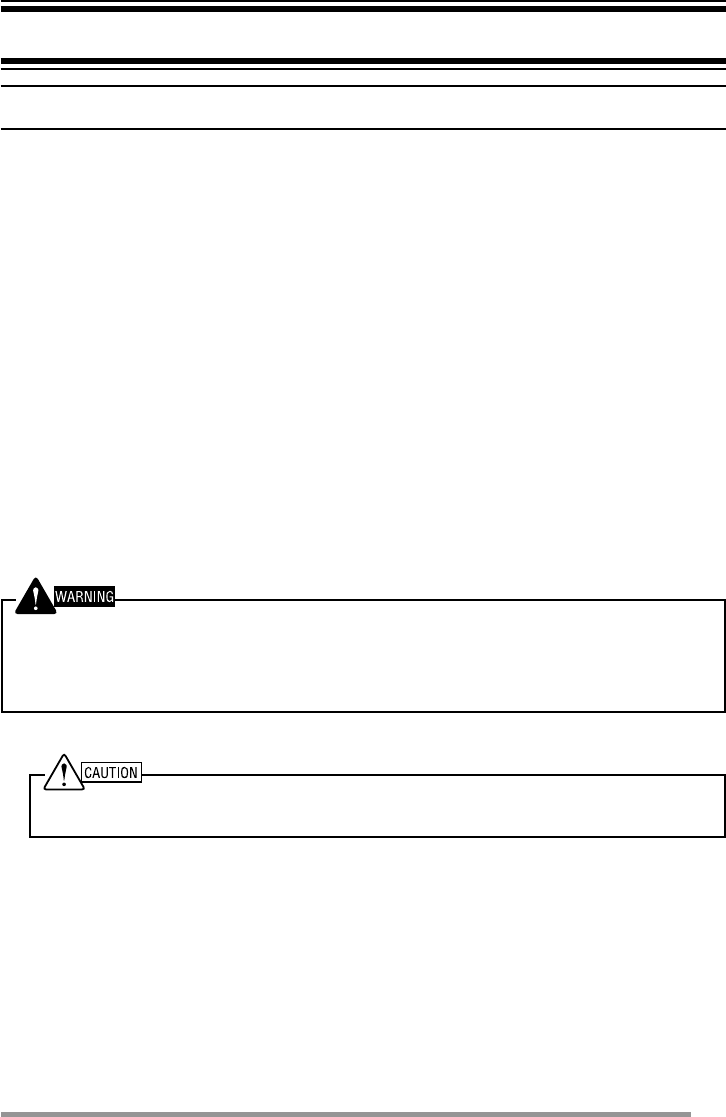
1
GETTING STARTED
Note: The following instructions are for use by your KENWOOD dealer, an authorized KENWOOD
service facility, or the factory.
SUPPLIED ACCESSORIES
Carefully unpack the transceiver. We recommend that you identify the items listed
below before discarding the packing material. If any items are missing or have
been damaged during shipment, fi le a claim with the carrier immediately.
DC power cable (with fuses). . . . . . . . . . . . . . . . . . . . . . . . . . . . . . . . . . . . . . . . . . . . . . . . . . . . . . 1
• 15 A fuse . . . . . . . . . . . . . . . . . . . . . . . . . . . . . . . . . . . . . . . . . . . . . . . . . . . . . . . . . . . . . . . . . 2
Mounting Bracket . . . . . . . . . . . . . . . . . . . . . . . . . . . . . . . . . . . . . . . . . . . . . . . . . . . . . . . . . . . . . . 1
Screw set
• 5 x 16 mm self-tapping screw. . . . . . . . . . . . . . . . . . . . . . . . . . . . . . . . . . . . . . . . . . . . . . . . . .4
• M4 x 8 mm Hex-headed screw with washer. . . . . . . . . . . . . . . . . . . . . . . . . . . . . . . . . . . . . . . 4
• Spring washer . . . . . . . . . . . . . . . . . . . . . . . . . . . . . . . . . . . . . . . . . . . . . . . . . . . . . . . . . . . . . 4
• Flat washer. . . . . . . . . . . . . . . . . . . . . . . . . . . . . . . . . . . . . . . . . . . . . . . . . . . . . . . . . . . . . . . . 4
Microphone (with cable)
• KMC-30 (NX-740H/ NX-840H) . . . . . . . . . . . . . . . . . . . . . . . . . . . . . . . . . . . . . . . . . . . . . . . . . 1
• KMC-35 (NX-740HV/ NX-840HU) . . . . . . . . . . . . . . . . . . . . . . . . . . . . . . . . . . . . . . . . . . . . . . 1
Microphone hanger (with 4 x 16 mm self-tapping screws) . . . . . . . . . . . . . . . . . . . . . . . . . . . . . . . 1
Instruction manual . . . . . . . . . . . . . . . . . . . . . . . . . . . . . . . . . . . . . . . . . . . . . . . . . . . . . . . . . . . . . 1
PREPARATION
Various electronic equipment in your vehicle may malfunction if they are not properly protected from
the radio frequency energy which is present while transmitting. Typical examples include electronic
fuel injection, anti-skid braking, and cruise control. If your vehicle contains such equipment, consult
the dealer for the make of vehicle and enlist his/her aid in determining if they will perform normally
while transmitting.
■ Power Cable Connection
The transceiver operates in 12 V negative ground systems only! Check the battery polarity and
voltage of the vehicle before installing the transceiver.
1 Check for an existing hole, conveniently located in the fi rewall, where the
power cable can be passed through.
• If no hole exists, use a circle cutter to drill a hole, then install a rubber grommet.
2 Run the power cable through the fi rewall and into the engine compartment.
3 Connect the red lead to the positive (+) battery terminal and the black lead
to the negative (–) battery terminal.
• Place the fuse as close to the battery as possible.
4 Coil the surplus cable and secure it with a retaining band.
• Be sure to leave enough slack in the cables so the transceiver can be removed
for servicing while keeping the power applied.
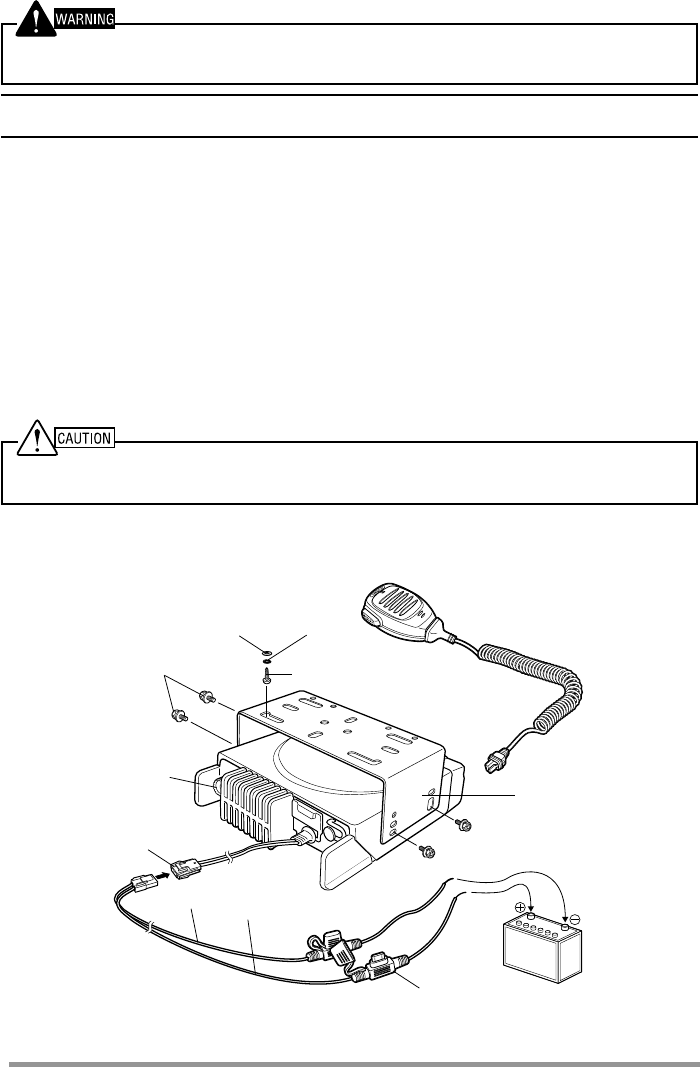
2
M4 x 8 mm
Hex-headed screw
DC power cable
Mounting bracket
Antenna
connector
Power input
connector
Fuse
Black (–) cable
Red (+) cable
12 V vehicle
battery
Microphone
5 x 16 mm
Self-tapping screw
Spring
washer
Flat
washer
■ Installing the Transceiver
For passenger safety, install the transceiver securely using the supplied mounting bracket and
screw set, so the transceiver will not break loose in the event of a collision.
Note: Before installing the transceiver, check how far the mounting screws will extend below
the surface. When drilling mounting holes, be careful not to damage vehicle wiring or parts.
1 Mark the position of the holes in the dash, using the mounting bracket as a
template. Using a 4.2 mm (5/32 inch) drill bit, drill the holes, then attach the
mounting bracket using the supplied screws.
• Mount the transceiver within easy reach of the user and where there is suffi cient
space at the rear of the transceiver for cable connections.
2 Connect the antenna and the supplied power cable to the transceiver.
3 Slide the transceiver into the mounting bracket and secure it using the
supplied hex-headed screws.
4 Mount the microphone hanger in a location where it will be within easy
reach of the user.
• The microphone and microphone cable should be mounted in a place where they
will not interfere with the safe operation of the vehicle.
When replacing the fuse in the DC power cable, be sure to replace it with a fuse of the same
value. Never replace a fuse with one that is rated with a higher value.
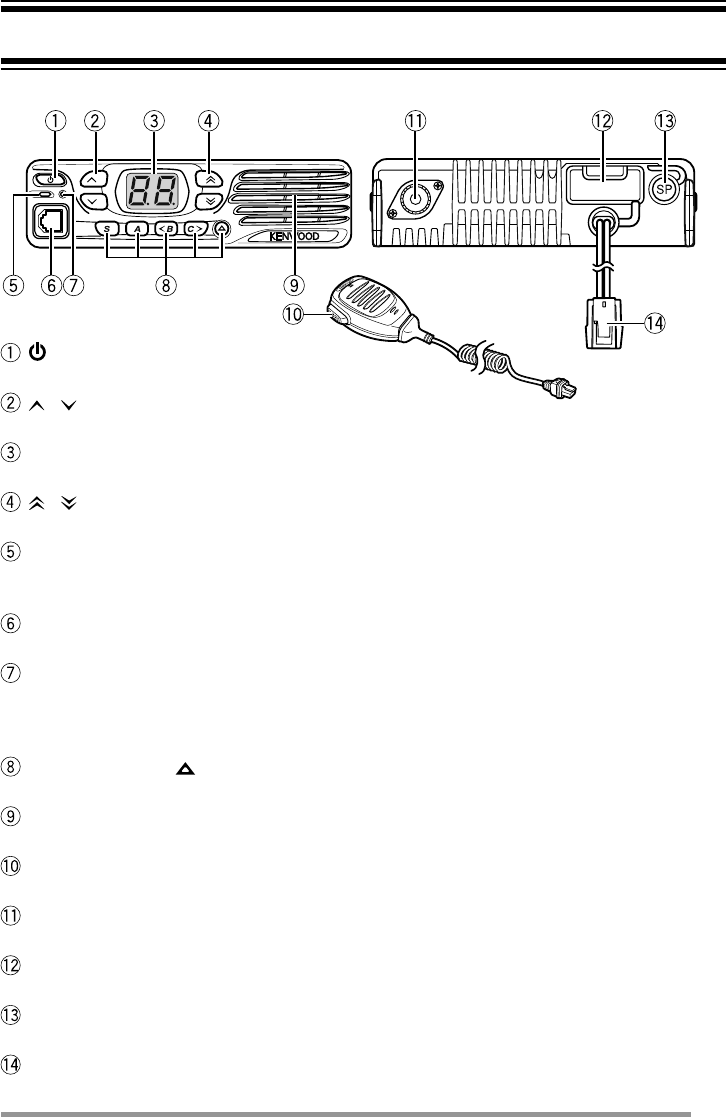
3
GETTING ACQUAINTED
(Power) switch
Press to switch the transceiver ON or OFF.
/ keys
Press to activate their programmable functions {page 6}.
Display
Refer to page 4.
/ keys
Press to activate their programmable functions {page 6}.
TX/RX Indicator
Lights red while transmitting. Lights green while receiving a signal. Flashes
orange when receiving an optional signaling call.
Microphone jack
Insert the microphone plug into this jack.
Status Indicator
Lights during a specifi ed mode, based on dealer programming.
(Such as AUX, External Speaker, Horn Alert, Lone Worker, Priority Zone-Channel
Select, Public Address, Scan Delete/Add, Scrambler/Encryption and Talk Around.)
S / A / <B / C> / keys
Press to activate their programmable functions {page 6}.
Speaker
Internal speaker.
PTT switch
Press this switch, then speak into the microphone to call a station.
Antenna connector
Connect the antenna to this connector.
ACC connector
Connect the ACC to this connector, via the KCT-60.
External speaker jack
Connect an external speaker to this jack.
Power input connector
Connect the DC Power Cable to this connector.
FRONT/ REAR PANEL
ACC.
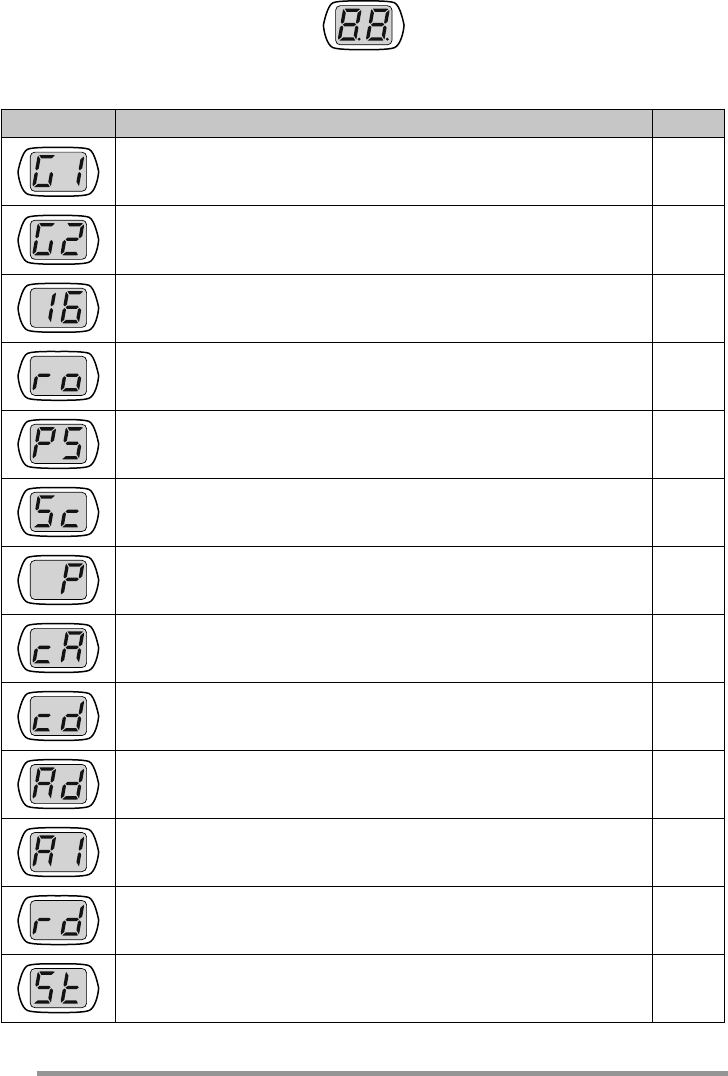
4
DISPLAY
The display shows the zone/ channel number and the 2 dots show various modes
of operation.
Display Description Page
Zone Display (Zone 1) 7
Zone Display (Zone 2) 7
Channel Display (Channel 16) 7
Appears during Site Roaming. (ro)
-
Appears when switch the transceiver ON.
The Transceiver Password function is programmed. (PS) 6
Appears during Scan. (Sc) 8
The selected channel is the Priority channel. (P) 9
Appears when a channel is added to the scan list. (cA) 9
Appears when a channel is removed from the scan list. (cd) 9
Appears when the Autodial mode is on. (Ad) 9
Autodial list Display (Autodial list 1) 9
Appears when the Redialing mode is on. (rd) 9
Appears during the transceiver is stunned. (St) 10
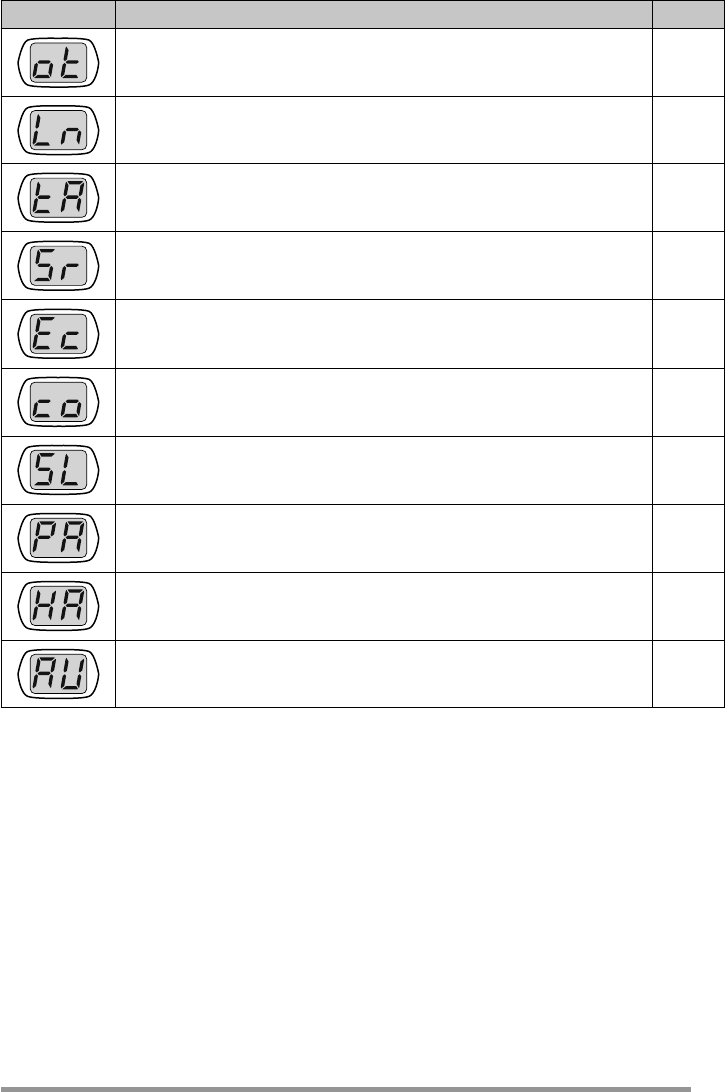
5
• AUX
• External Speaker
• Horn Alert
• Lone Worker
• Priority Zone-Channel
• Public Address
• Scan Delete/Add
• Scrambler/Encryption
• Talk Around
The right dot will blink during special operations, as listed below.
Display Description Page
Appears when the Operator Selectable Tone mode is on. (ot) 11
Appears when the Lone Worker function is on. (Ln) 12
Appears when the Talk Around function is on. (tA) 12
Appears when the Scrambler function is on. (Sr) 12
Appears when the Encryption function is on. (Ec) 12
Appears when the Scrambler/ Encryption code mode is on. (co) 12
Appears when the Squelch Level setting is on. (SL) 13
Appears when the Public Address function is on. (PA) 13
Appears when the Horn Alert function is on. (HA) 13
Appears when the AUX function is on. (AU) 14
The left and right dots on the display can be programmed to indicate specifi c
modes of operation, as listed below.
• Autodial
• Operator Selectable Tone
• Channel Entry
• Scrambler/Encryption Code
• Squelch Level

6
BASIC OPERATIONS
SWITCHING POWER ON/ OFF
Press to switch the transceiver ON.
• A beep sounds and the display illuminates.
• If the Transceiver Password function is programmed, “PS” will appear on the display
when the power is turned ON. Refer to “Transceiver Password”, below.
Press again to switch the transceiver OFF.
PROGRAMMABLE FUNCTIONS
The , , , , S, A, <B, C>, and keys can be programmed with the functions
listed below. Ask your dealer for details on these functions.
• None
• Autodial
1
• AUX
• Call 1/ Call 2
• Channel Down
• Channel Entry
• Channel Up
• CW Message
2
• Direct Zone-Channel
• Emergency
3
• External Speaker
• Horn Alert
• LED Brightness
• Lone Worker
• Monitor
• Monitor Momentary
• Paging Call
• Priority Zone-Channel Select
• Squelch Off
1
• Squelch Off Momentary 1
• Operator Selectable Tone
1
• Public Address
• Scan
• Scan Delete/Add
• Scrambler/Encryption
• Scrambler/Encryption Code
• Send the GPS Data
• Squelch Level
1
• Talk Around
• Volume Down
• Volume Up
• Zone Down
• Zone Up
1 Available only for Analog operation.
2 Available only for NXDN operation.
3 Emergency can be programmed only on the key.

7
■ Transceiver Password
To enter the password:
1 Press / to select a digit.
• When using an optional microphone with a keypad, simply enter the password
digits and proceed to step 3.
2 Press C> to accept the entered digit and move to the next digit.
• Press A or # to delete an incorrect digit. Press and hold A or # to delete all digits.
• Repeat steps 1 and 2 to enter the entire password.
3 Press S or to confi rm the password.
• If you enter an incorrect password, the transceiver remains locked.
ADJUSTING THE VOLUME
Press the [Volume Up] key to increase the volume. Press the [Volume Down]
key to decrease the volume.
If Squelch Off has been programmed onto a key, you can use that function to
listen to background noise while adjusting the volume level.
SELECTING A ZONE AND CHANNEL
Select the desired zone and channel using the keys programmed as [Zone Up]/
[Zone Down] and [Channel Up]/ [Channel Down].
• “G1” (Zone 1)/ “16” (Channel 16) appears on the display.
TRANSMITTING
1 Select your desired zone and channel.
2 Press the key programmed as [Monitor] or [Squelch Off] to check whether or
not the channel is free.
• If the channel is busy, wait until it becomes free.
3 Press the PTT switch and speak into the microphone to transmit. Release the
PTT switch to receive.
• For best sound quality at the receiving station, hold the microphone approximately
1.5 inches (3 cm ~ 4 cm) from your mouth.
RECEIVING
Select the desired zone and channel. If signaling has been programmed on the
selected channel, you will hear a call only if the received signal matches your
transceiver settings.
Note: Signaling allows your transceiver to code your calls. This will prevent you from listening to
unwanted calls. Refer to “SIGNALING” on page 10 for details.

8
NXDN
NXDN is a general term for the NXDN wireless communication protocol which
uses 4 Level FSK. Various data communications, including individual and group
voice communications, Status calls, and GPS data transmission, are possible.
INDIVIDUAL/ GROUP CALLS
Each channel is set up with an individual or group ID list number. To make a call,
select the channel with the ID list number you wish to call, then press the PTT
switch to start the call.
• Your dealer may also have set Selcall on PTT for Individual or Group calls, allowing you
to make an Individual or Group call when pressing the PTT switch.
• To page the target transceiver instead of initiating a voice call, press the key
programmed as [Paging Call].
• If PTT Proceed tone is enabled, the Proceed tone will sound. After the tone ends, you
can begin the call.
■ Receiving
When you receive an individual call, a ringing tone will sound. Respond to the
call by pressing the PTT switch.
• If the auto reset timer expires before you respond to the call, the call will end. Your
dealer can set the duration for the auto reset timer (default is 10 seconds).
When you receive a group call and the received group ID matches the ID set
up on your transceiver, a ringing tone will sound and you can hear the caller’s
voice.
STATUS CALL
You can transmit your status (preset by your dealer) to the target transceiver by
pressing the key programmed as [Call 1] or [Call 2], if they have been set up with
an NXDN Status.
• Select the desired channel before sending the status call.
SCAN
Scan monitors for signals on the transceiver channels. While scanning, the
transceiver checks for a signal on each channel and only stops if a matching
signal is present.
To start/ stop scanning, press the key programmed as [Scan].
• “Sc” appears on the display during Scan.
• When a signal is detected, Scan pauses at that channel. The transceiver will remain on
the busy channel until the signal is no longer present, at which time Scan resumes.
Note: To use Scan, there must be at least 2 channels added to the scanning sequence.
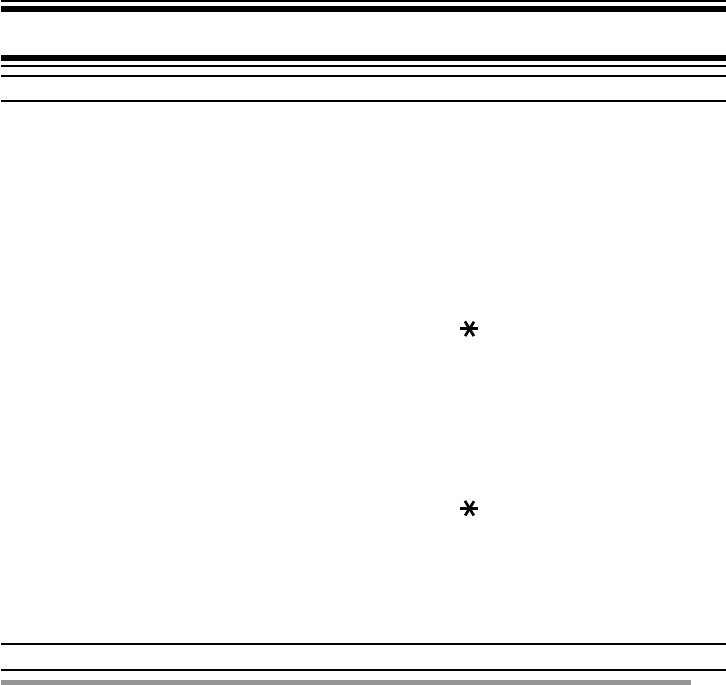
9
PRIORITY SCAN
If a Priority channel has been programmed, the transceiver will automatically
change to the Priority channel when a call is received on that channel, even if call
is being received on a normal channel.
• “P” appears on the display to indicate the Priority channel (depending on dealer setting).
TEMPORARY CHANNEL LOCKOUT
During scan, you can temporarily remove specifi c channels from the scanning
sequence by pressing the key programmed as [Scan Delete/Add] while Scan is
paused at the undesired channel.
• The channel is no longer scanned. However, when scanning is ended and restarted, the
Scan settings return to normal.
SCAN DELETE/ ADD
You can add and remove channels to and from your scan list.
1 Select your desired channel.
2 Press the key programmed as [Scan Delete/Add] to remove a channel.
• When a channel is added to scan, “cA” appears on the display. When it is removed,
“cd” appears on the display.
DTMF CALLS
Note: For keypad operation, you must use an optional microphone with a keypad.
MANUAL DIALING
1 Press and hold the PTT switch.
2 Enter the desired digits using the keypad.
• If Keypad Auto-PTT is enabled by your dealer, you do not need to press the PTT
switch to transmit; you can make the call simply by pressing the keys.
AUTODIAL
Autodial allows you to quickly call DTMF numbers that have been programmed
onto your transceiver.
1 Press the key programmed as [Autodial] or the key.
• “Ad” appears on the display.
2 Press <B and C> to select your desired Autodial list number, or enter the list
number directly (1 ~ 9).
• “A1” (Autodial list 1) appears on the display.
3 Press the PTT switch to make the call.
REDIALING
1 Press the key programmed as [Autodial] or the key.
• “Ad” appears on the display.
2 Press the 0 key.
• “rd” appears on the display.
• If there is no data in the redial memory, an error tone will sound.
3 Press the PTT switch to make the call.
Note: Switching the transceiver power OFF clears the redial memory.

10
STUN
This function is used when a transceiver is stolen or lost. When the transceiver
receives a call containing a stun code, the transceiver becomes disabled. The
stun code is canceled when the transceiver receives a call with a revive code.
• “St” appears on the display while the transceiver is stunned.
SIGNALING
QUIET TALK (QT)/ DIGITAL QUIET TALK (DQT)
The Encoder/ Decoder function uses QT/ DQT to segregate talk groups, so users
only hear calls from their own group.
RADIO ACCESS NUMBER (RAN)
RAN is a signaling system designed for digital radio communications. When a
channel is set up with a RAN, squelch will only open when a call containing a
matching RAN is received. If a call containing a different RAN is made on the
channel you are using, you will not hear the call. This allows you to ignore (not
hear) calls from other parties who are using the same channel.
NXDN ID
NXDN ID is an optional signaling system available only for digital communications.
DTMF
A DTMF PTT ID is included for dispatch operations or simple remote control
applications. The DTMF decode capabilities include Selective Call ID, Transpond
with ID, and “Wild Card” Group Calling.
2-TONE
2-tone Signaling opens the squelch only when your transceiver receives a call
containing matching 2 tones.
FleetSync
Refer to “SELCALL (SELECTIVE CALLING)” on page 11.
MDC-1200
The following features are available with the built-in MDC signaling: PTT ID
Encode, Emergency Encode, Stun/ Revive Decode, and Radio Check Decode.
Note: The transceiver cannot decode MDC-1200 if the FleetSync baud rate is 2400 bps.

11
FleetSync: ALPHANUMERIC 2-WAY PAGING FUNCTION
FleetSync is an Alphanumeric 2-way Paging Function and is a protocol owned by
JVC KENWOOD Corporation.
Note: If set up by your dealer, your transceiver may use the MDC-1200 feature in place of
FleetSync. MDC-1200 and FleetSync cannot be operated simultaneously.
SELCALL (SELECTIVE CALLING)
A Selcall is a voice call to a particular station or to a group of stations.
■ Transmitting
1 Select your desired zone and channel.
2 Press the PTT switch to transmit your PTT ID list and begin your conversation.
■ Receiving
If enabled by your dealer, an alert tone will sound and the LED will blink when
a Selcall has been received.
To respond to the call, press the PTT switch and speak into the microphone.
■ Identifi cation Codes
An ID code is a combination of a 3-digit Fleet number and a 4-digit ID number.
Each transceiver must have its own Fleet and ID number.
Note: The ID range may be limited by programming.
PAGING CALL
1 Select your desired zone and channel.
2 Press and hold the key programmed as [Paging Call] for 1 second to transmit
your PTT ID list, to request a call.
GPS REPORT
If a GPS unit (NMEA-0183 format) is installed on your transceiver, you can press
the key programmed as [Send the GPS data] to send your location data.
OPERATOR SELECTABLE TONE (OST)
You can change the preset encode and decode tones for the selected channel.
Up to 16 OST pairs can be pre-programmed by your dealer.
1 Select your desired channel.
2 Press the key programmed as [Operator Selectable Tone] or press and hold
the key.
• “ot” appears on the display, followed by the current OST number.
3 Press <B and C> to select the desired OST number.
4 Use the transceiver the same as in a regular call; press the PTT switch to
transmit and release it to receive.
5 To exit OST mode and return to the preset encode and decode tones, press S.

12
ADVANCED OPERATIONS
EMERGENCY CALLS
If your transceiver has been programmed with the Emergency function, you can
make emergency calls.
1 Press and hold the key programmed as [Emergency].
• Depending on the delay time programmed into your transceiver, the length of time
you must hold the [Emergency] key will vary.
• When the transceiver enters Emergency mode, the transceiver will change to the
Emergency channel and begin transmitting based on how the transceiver is set up.
2 To exit Emergency mode, press and hold the [Emergency] key again.
• If the Emergency mode completes the preset number of cycles, Emergency mode
will automatically end and the transceiver will return to normal.
■ Lone Worker Mode
Lone Worker Mode is a safety feature built into the transceiver. If the
transceiver is not operated for a pre-programmed period of time, the
transceiver will emit a tone and automatically enter Emergency operation.
Press the key programmed as [Lone Worker] to toggle the Lone Worker
function ON or OFF.
• “Ln” appears on the display for 1 second.
TALK AROUND
During interruptions in service (such as a power failure), you can continue
to communicate by using the Talk Around feature. Talk Around allows you to
communicate directly with other transceivers without the use of a repeater, as long
they are not too far away or there are no geographical obstacles in the way.
Press the key programmed as [Talk Around] to toggle the Talk Around function
ON or OFF.
• “tA” appears on the display for 1 second.
SCRAMBLER/ ENCRYPTION
The Scrambler (analog) and Encryption (NXDN) function allows you to hold a
conversation in complete privacy. When activated, any other party listening in on
your channel will be unable to understand your conversation. Press this key to
toggle the Scrambler/ Encryption function ON or OFF.
Press the key programmed as [Scrambler/Encryption] to toggle the Scrambler/
Encryption function ON or OFF.
• “Sr”(analog)/ ”Ec”(NXDN) appears on the display for 1 second.
You can change the scrambler/ encryption codes:

13
1 Press and hold the key programmed as [Scrambler/Encryption code] for 1
second.
• “co” (code) appears on the display, followed by the current scrambler/ encryption code.
2 Press <B and C> to select your desired scrambler/ encryption code.
3 Press S or to store the new setting.
• After changing your scrambler/ encryption code, be sure to inform all of your group
members of the new code so they can also reset their transceivers. The scrambler/
encryption function will not work with transceivers set up with different scrambler/
encryption codes.
MONITOR/ SQUELCH OFF
You can use the key programmed as [Monitor] or [Squelch Off] to listen to weak
signals that you cannot hear during normal operation and to adjust the volume
when no signals are present on your selected channel.
Your dealer can program a key with one of 4 functions:
• Monitor: Press to deactivate QT, DQT, DTMF, FleetSync Signaling, or NXDN. Press
again to return to normal operation.
• Monitor Momentary: Press and hold to deactivate QT, DQT, DTMF, FleetSync
Signaling, or NXDN. Release to return to normal operation.
• Squelch Off: Press to hear background noise. Press again to return to normal
operation.
• Squelch Off Momentary: Press and hold to hear background noise. Release to return
to normal operation.
■ Squelch Level
If a key has been programmed as [Squelch Level], you can readjust your
transceiver’s squelch level:
1 Press the key programmed as [Squelch Level].
• “SL” appears on the display, followed by the current squelch level.
2 Press <B and C> to select the desired squelch level from 0 to 9.
3 Press S or to store the new setting.
PUBLIC ADDRESS (PA)
The PA system can only be used with an optional relay unit and external speaker.
1 Press the key programmed as [Public Address] to activate the Public Address
function.
• “PA” appears on the display for 1 second.
2 Press and hold the PTT switch, then speak into the microphone to make your
address through the external speaker.
3 Press the [Public Address] key again to exit Public Address.
HORN ALERT
The Horn Alert function can only be used with an optional relay unit.
Press the key programmed as [Horn Alert] to toggle the Horn Alert function ON
or OFF.
• “HA” appears on the display for 1 second.

14
BACKGROUND OPERATIONS
TIME-OUT TIMER (TOT)
The Time-out Timer is used to prevent you from using a channel for an extended
duration. If you continuously transmit for a preset time, the transceiver will stop
transmitting and a warning tone will sound. Release the PTT switch to stop the tone.
AUXILIARY PORT
Press the key programmed as [AUX] to activate the auxiliary port. The auxiliary
port is used with optional boards.
• “AU” appears on the display for 1 second.
DISPLAY BRIGHTNESS
You can cycle the display brightness between high, low, and off by pressing the
key programmed as [LED Brightness].
DIRECT ZONE CHANNEL
Press the key programmed as [Direct Zone-Channel] to immediately select the
lowest channel of the lowest zone.
BUSY CHANNEL LOCKOUT (BCL)
When activated, BCL prevents you from interfering on a channel that is already
in use. Pressing the PTT switch will cause a warning tone to sound and the
transceiver will not transmit. Release the PTT switch to stop the tone.
Note: Ask your dealer for an explanation on how BCL functions when using QT, DQT, RAN, or
Optional signaling.
If BCL Override has been programmed, you can transmit over the current signal:
1 Press and hold the PTT switch.
• If the channel is already in use, a warning tone will sound.
2 Quickly release and then press the PTT switch again.
3 Speak into the transceiver as you would during a normal call.
PTT ID
PTT ID is the transceiver unique ID code which is sent each time the PTT switch
is pressed and/or released.
Note: PTT ID can be made only in analog operation.
COMPANDER
If programmed by your dealer for a channel, the compander will remove excessive
noise from transmitted signals, to provide higher clarity of signals.
Note: The compander is used only in analog operation.
VOICE ANNOUNCEMENT
When changing the zone/ channel, an audio voice will announce the new zone/
channel number.
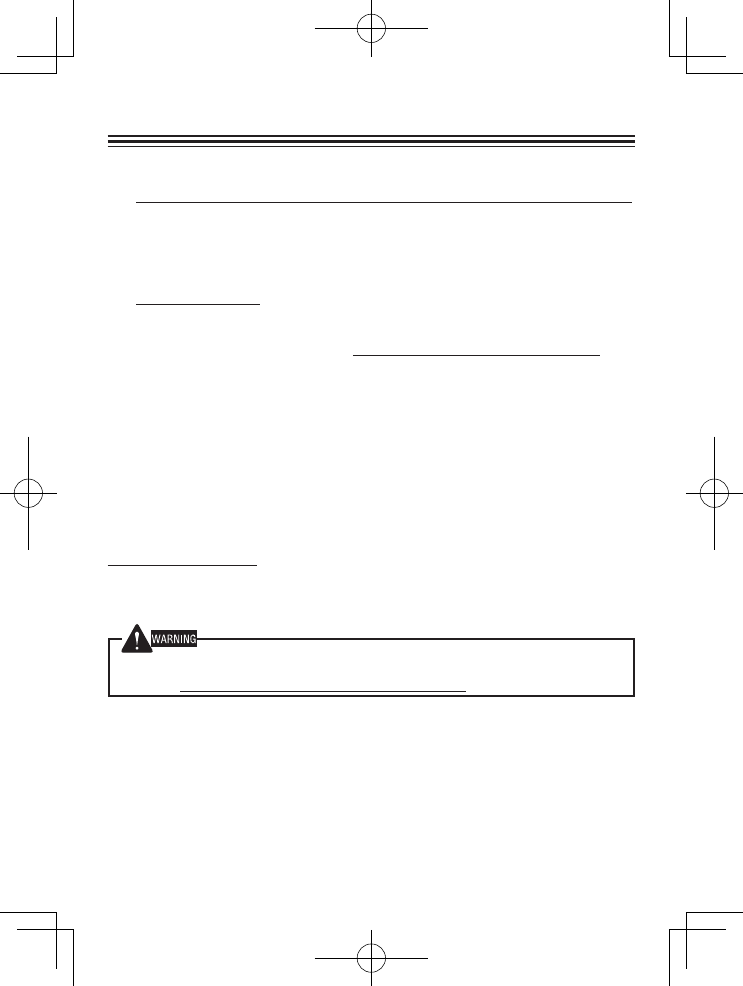
MANDATORY SAFETY INSTRUCTIONS TO INSTALLERS AND USERS
• Use only manufacturer or dealer supplied antennas.
• Antenna Minimum Safe Distance: 40 cm (16 inches), 50% duty Cycle.
• Antenna Gain: 0 dBd referenced to a dipole.
The Federal Communications Commission has adopted a safety standard
for human exposure to RF (Radio Frequency) energy which is below the
OSHA (Occupational Safety and Health Act) limits.
•
Antenna Mounting: The antenna supplied by the manufacturer or radio
dealer must not be mounted at a location such that during radio transmission,
any person or persons can come closer than the above indicated minimum
safe distance to the antenna, i.e. 40 cm (16 inches) , 50% duty Cycle.
• To comply with current FCC RF Exposure limits, the antenna must
be installed at or exceeding the minimum safe distance shown
above, and in accordance with the requirements of the antenna
manufacturer or supplier.
•
Vehicle installation: The antenna can be mounted at the center of a
vehicle metal roof or trunk lid, if the minimum safe distance is observed.
• Base Station Installation: The antenna should be fixed-mounted on
an outdoor permanent structure. RF Exposure compliance must be
addressed at the time of installation.
Antenna substitution: Do not substitute any antenna for the one supplied
or recommended by the manufacturer or radio dealer.
You may be exposing person or persons to excess radio frequency radiation.
You may contact your radio dealer or the manufacturer for further instructions.
Maintain a separation distance from the antenna to person(s) of
at least 40 cm (16 inches), 50% duty Cycle.
“This transmitter is authorized to operate with a maximum duty factor of 50%, in
typical push-to-talk mode, for satisfying FCC RF exposure compliance requirements.”
You, as the qualified end-user of this radio device must control the exposure
conditions of bystanders to ensure the minimum separation distance (above) is
maintained between the antenna and nearby persons for satisfying RF Exposure
compliance. The operation of this transmitter must satisfy the requirements of
Occupational/Controlled Exposure Environment, for work-related use, transmit
only when person(s) are at least the minimum distance from the properly installed,
externally mounted antenna. Transmit only when people outside the vehicle are at
least the recommended minimum lateral distance away from the antenna/vehicle.
B59-2723-00